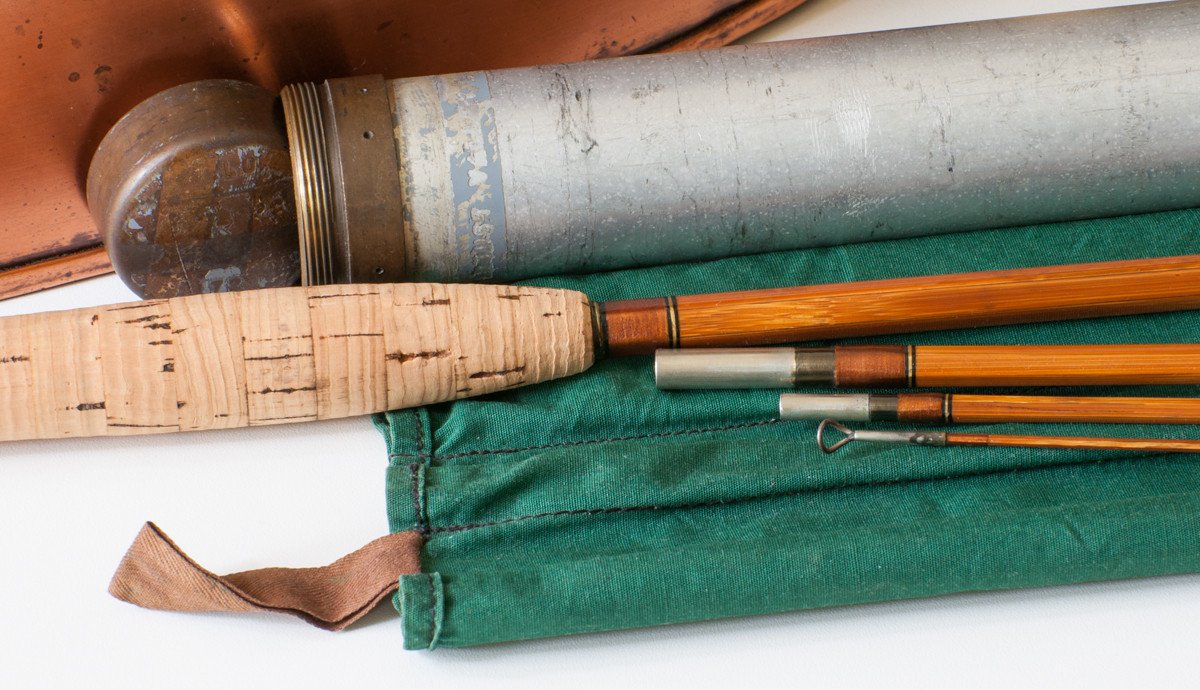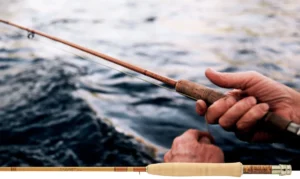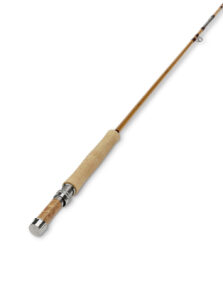
American Museum of Fly Fishing amff.org
Key Takeaways
-
Custom bamboo fly rods, like those crafted by H.S. “Pinky” Gillum, are highly valued for their sensitivity and strength, especially in small stream settings.
-
Each Gillum rod is a piece of fly fishing history, handcrafted with precision and tailored to the angler’s needs.
-
The process of creating a Gillum bamboo rod is an art, involving careful selection of materials, meticulous handcrafting, and a deep understanding of fishing dynamics.
-
Bamboo rods are not just tools but heirlooms, requiring proper care and maintenance to preserve their functionality and beauty.
-
Understanding the nuances of bamboo rod action and taper can greatly enhance your fly fishing technique and success in catching trout.
Discovering Gillum’s Legacy in Small Stream Trout Fishing
When you wade through the cool, whispering waters of a small stream, your senses are heightened. You become part of the environment, and the rod in your hand is your primary connection to the underwater world of trout. A custom bamboo fly rod by H.S. “Pinky” Gillum is more than a fishing tool; it’s a conduit to the soul of angling, a legacy of craftsmanship that transforms the fishing experience.
The Tradition of Bamboo Rods in Fly Fishing
Bamboo fly rods have been the cornerstone of fly fishing for over a century. Anglers cherish them for their natural feel, the warm aesthetic of the cane, and the unparalleled presentation they offer. There’s a rhythm to casting a bamboo rod that synthetic materials struggle to replicate. This connection to tradition is palpable when you hold a rod that’s been shaped by hand, knowing it was crafted with the same time-honored techniques used by generations before.
What Makes Handcrafted Rods Superior
Handcrafted rods are superior because they are built with intention. Every aspect of a custom bamboo rod is thoughtfully considered and executed. From selecting the perfect culm of Tonkin bamboo to applying the final coat of varnish, the maker imbues the rod with a level of care that factory models can’t match. This attention to detail results in a rod that is not only beautiful but also performs with precision and sensitivity on the water.
Unwrapping the Craftsmanship Behind Bamboo Fly Rods
The journey from raw bamboo to a finished Gillum rod is a tale of transformation. It begins with the selection of Tonkin bamboo, prized for its dense fibers and natural resilience. The culms are split by hand, then meticulously planed to exacting dimensions. The strips are tapered, glued, and bound together, forming the rod’s blank. It’s a process that requires patience, skill, and an intimate knowledge of how a rod should feel in the hand and respond to the water.
The Journey From Raw Bamboo to a Gillum Rod
The creation of a bamboo fly rod is a journey through craftsmanship and history. Harold “Pinky” Gillum was a master of this art, blending traditional methods with his unique innovations. He understood that the quality of the bamboo itself set the foundation for the rod’s performance. Oven-tempering, a technique he pioneered, enhanced the bamboo’s strength and resilience. Each step in the rod-making process was an opportunity for refinement, a chance to enhance the angler’s connection to the fish.
Techniques and Tools of the Trade
The tools and techniques used in crafting a bamboo rod may seem simple, but they require a high level of expertise. Planing forms, specialized knives, and binding machines are just a few of the instruments that rod builders use. But beyond the tools, it’s the maker’s touch—the eye for symmetry, the intuition for balance—that turns these instruments into extensions of the craftsman’s hands. The outcome is a rod that’s perfectly suited for the delicate presentation of a fly on a small stream.
For example, consider the careful application of heat in the tempering process. It’s not just about following a set time or temperature—it’s about watching the bamboo change color, sensing the aroma of the cane, and knowing, just by feel, when it has reached the perfect state of temper.
Let’s take a brief pause here. In the next section, we’ll delve into why bamboo rods, particularly those made by Gillum, are so well-suited for small stream trout fishing. We’ll explore the unique characteristics that give these rods their legendary status among anglers. Stay tuned.
Why Bamboo Rods Excel in Small Stream Settings
In the world of fly fishing, the environment plays a pivotal role in the equipment we choose. Small streams, with their intricate ecosystems and tight casting spots, demand a rod that can offer precision and delicacy. This is where bamboo rods, particularly those handcrafted by masters like Gillum, come into their own. Their natural flexibility and slower action allow for a softer presentation of the fly, which is crucial in not spooking the skittish trout these waters often hold.
The Science of Sensitivity and Strength
The inherent qualities of bamboo make it an exceptional material for crafting fly rods. Unlike stiffer, modern materials, bamboo has a remarkable ability to bend and flex while maintaining its strength. This combination of sensitivity and strength means you can feel every subtle take and nudge from a trout, while also having the backbone to set the hook firmly. It’s a delicate balance that Gillum rods have perfected over decades.
Maneuvering Through the Delicate Ecosystem
Small streams are often densely vegetated, with overhanging branches and submerged logs. These conditions require a rod that can navigate obstacles with ease. A Gillum bamboo rod, with its precise casting ability, lets you place your fly exactly where it needs to go. This isn’t just about avoiding snags; it’s about being able to present your fly in a natural drift, one that mimics the insects the trout are feeding on.
Mastering the Cast with a Gillum Rod
The cast is the heart of fly fishing. With a Gillum rod in hand, you’re not just casting a line; you’re creating art in motion. The smooth, rhythmic action of a bamboo rod demands a refined technique, one that’s built on timing and finesse rather than power. It’s about feeling the rod load and unload, using its natural energy to propel the fly forward. When mastered, it’s a thing of beauty and effectiveness.
Understanding Rod Action and Taper
Rod action refers to how a rod flexes under the load of a line during a cast. Gillum rods are known for their medium to slow action, bending deeply into the mid-section and sometimes into the butt of the rod. Taper, on the other hand, is the change in diameter of the rod from butt to tip. A masterfully crafted taper affects how power is distributed through the rod during the cast. Gillum’s tapers are renowned for their ability to transfer energy smoothly, which is key to the delicate presentations required in small streams.
The combination of action and taper in a Gillum rod means that each cast can be both gentle and precise. This is crucial when targeting trout that are easily spooked by heavy splashes or unnatural movements. It’s the subtlety of the cast, the ability to lay the fly on the water like a falling leaf, that often separates a good day on the stream from a great one.
Optimizing Your Technique for Trout
To truly harness the potential of a Gillum bamboo rod, your casting technique must be on point. Here are some tips to get you started:
-
Focus on your timing. Allow the rod to fully load on your back cast before transitioning to your forward cast.
-
Keep your wrist firm and use your forearm to drive the cast. This will help maintain the smooth arc needed for a bamboo rod.
-
Practice accuracy. Set up targets at varying distances and work on hitting them consistently.
-
Be mindful of your surroundings. Use roll casts and sidearm casts to navigate around obstacles.
-
Remember, it’s not about power. Let the rod do the work, and focus on maintaining a controlled, even tempo.
With practice, you’ll find that casting with a Gillum rod becomes second nature. You’ll be able to drop your fly into pockets of water that seemed unreachable before, and you’ll do it with such stealth that even the wariest of trout will be none the wiser.
Consider the words of a seasoned angler: “The first time I cast a Gillum, it was like the rod knew where I wanted the fly to go. It was an extension of my arm, my intentions carried through bamboo and silk to the water’s surface.”
Next, we’ll dive into the experience of fishing with a Gillum rod and how it connects you to the history of fly fishing. You’ll learn why these rods are more than just tools, but treasures that bring stories to life with every cast.
Stories From the Stream: Anglers’ Tales
There’s a certain magic to the stories that come from a day of fishing with a Gillum rod. Like the tale of an old-timer who, with a flick of the wrist, landed a trophy brown trout from a seemingly impossible bend in the stream. Or the story of a novice angler who, under the guidance of a seasoned mentor, felt the thrill of their first catch on a rod that seemed to whisper the river’s secrets. These are the narratives that bind the fly fishing community, tales of triumph, respect for nature, and the rods that make them possible.
Preserving and Caring for Your Gillum Bamboo Rod
A bamboo rod is not just a fishing implement; it’s a legacy that requires care to preserve its function and beauty. Protecting your Gillum rod involves regular cleaning, careful handling, and proper storage. After each use, it’s important to wipe down the rod with a soft cloth to remove any moisture or debris. Store the rod in a cool, dry place, away from direct sunlight and heat sources. When assembled, support the rod at multiple points to prevent any warping or bending over time.
Frequently Asked Questions
Fly fishing enthusiasts often have questions about the unique characteristics and care of bamboo rods. Let’s address some of the most common inquiries.
How do bamboo fly rods differ from modern materials?
Bamboo rods are distinct in their natural material and handcrafted construction. Unlike modern graphite or fiberglass rods, bamboo offers a unique flex and feel, providing a more connected and nuanced fishing experience. They require more attentive casting techniques but reward the angler with a graceful presentation and sensitivity that modern materials can’t quite replicate.
What makes Gillum rods particularly suited for small streams?
Gillum rods are designed with the small stream in mind. Their slower action and delicate taper allow for precise, gentle casts that are ideal for the intricate environments of these waterways. The sensitivity of the rod enables anglers to detect subtle takes, and the strength of bamboo ensures solid hooksets, even with the lightest of tippets.
Are bamboo rods suitable for beginners in fly fishing?
While bamboo rods demand a more refined casting technique, they can be excellent tools for beginners who are willing to invest the time to learn. The feedback provided by a bamboo rod can accelerate the learning curve, helping new anglers develop a feel for the water and the behavior of their line.
Besides that, the legacy and stories behind these rods can inspire novices to connect with the history and art of fly fishing, enriching their experience from the start.
Can bamboo rods be repaired if they are damaged?
Yes, bamboo rods can often be repaired, even when they suffer significant damage. Skilled craftsmen can replace sections, rebind guides, and restore finishes. However, repairs should be entrusted to professionals who specialize in bamboo rod restoration to ensure the integrity and performance of the rod is maintained.
In conclusion, a Gillum bamboo fly rod is more than a fishing tool; it’s a gateway to the heart of fly fishing. Whether you’re a seasoned angler or a beginner, the care and mastery behind each rod offer a timeless experience, connecting you to the craft’s rich heritage and the quiet thrill of small stream trout fishing. As you step into the stream with a Gillum rod in hand, you’re not just fishing; you’re part of a story that continues with every cast and every catch—a story that’s yours to tell.

Spinoza Rod Company SpinozaRods.com




